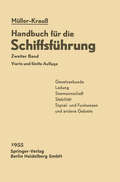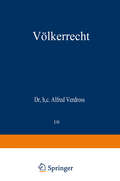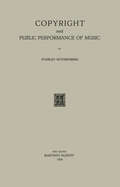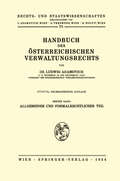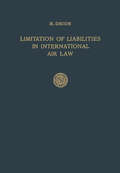- Table View
- List View
Ärztliches Haftpflichtrecht: Seine Grundlagen und Seine Bedeutung im Verhältnis des Arztes und des Krankenhauses zum Patienten
by Artur H. Huebner Heinrich DrostDieses Buch ist in erster Reihe für den Arzt und den Krankenhausinhaber geschrieben. Es soll ihnen einen überblick darüber geben, unter welchen Voraussetzungen sie sich einen Schadensersatzanspruch des Patienten zu ziehen können, und wie sie sich verhalten müssen, um derartige Ansprüche zu vermeiden. In den Teilen A bis C ist die Rechtslage des Arztes und des Kranken hauses in großen Zügen zur Darstellung gebracht, während in Teil D eine erhebliche Zahl von Haftpflichtfällen ärztlicher Fehlbehandlung erörtert ist. Im Anhang sind zur näheren Erläuterung der Teile A bis D 34 Entschei dungen des Reichsgerichts und des Bundesgerichtshofes, größtenteils im Wortlaut, wiedergegeben, soweit dieser für den Arzt oder den Kranken hausträger von Interesse ist. Nach dieser Anordnung des Buches wird auch der Jurist und der Ver sicherer, der in seiner beruflichen Tätigkeit einen Fall ärztlimer Haftpflimt zu bearbeiten hat, sich leicht über die Rechtsgrundsätze unterrichten können, die auf seinen Fall anwendbar sind. Das Buch ist in einer Gemeinschaftsarbeit von Arzt und Jurist entstanden A. Hübner und H. Drost. Inhaltsverzeichnis. Seite A. Die rechtliche Stellung des Arztes und des Krankenhauses . I. Die öffentlich-rechtliche Stellung des Arztes .
Brieflexikon für Steuerzahler
by Hermann FrohnhäuserDas vorliegende "Brieflexikon für Steuerzahler" bietet eine wertvolle Ergänzung des in unserem Leserkreis so günstig aufgenommenen "Brief lexikons für Kaufleute". Schon dieses enthielt einen Abschnitt "Verkehr mit den Steuerbehörden". Die große Bedeutung, die dem Verkehr mit unserem "stillen Teilhaber", dem Finanzamt, zukommt, hat uns veran laßt, das vorliegende Spezialwerk herauszugeben. Sein Studium ist gleich aufschlußreich für Kaufleute, Lernende und Fachleute. Der Verfasser verfügt über eine jahrzehntelange Berufserfahrung. Viele Spezialisten haben ihn bei der Abfassung unterstützt. Daß hierbei auch die Vorschriften des Steuerneuordnungsgesetzes vom 16. 12. 1954 berück sichtigt worden sind, ist eine Selbstverständlichkeit, wenn auch die Brief muster nach Möglichkeit so gehalten sind, daß sie zeitlos gültig sind. Das Werk enthält einschließlich der Varianten über 470 Musterbriefe, davon rund 100 aus dem Gebiet der Betriebsprüfung und der Steuerfahndung. Der Verfasser hat den Musterbriefen in seinen Vorbemerkungen Hinweise allgemeiner Art über den Verkehr mit den Finanzbehörden vorangestellt, die Allgemeingut aller Steuerpflichtigen sein sollten. Außerdem gibt er zu besonders wichtigen grundsätzlichen Fragen an das Finanzamt gleichzeitig die Antwort, was wesentlich zum Verständnis der mitunter schwierigen Materie beiträgt. So hoffen wir, für die Bedürfnisse der Praxis ein über den Rahmen einer bloßen Briefsammlung hinausgehendes Nachschlagewerk geschaffen zu haben, das höchsten Anforderungen genügt.
The Court of Justice of the European Coal and Steel Community
by D.G. ValentineTHE CREATION OF THE COURT OF JUSTICE OF THE EUROPEAN COAL AND STEEL COMMUNITY On 9th May, 1950, M. Robert Schuman, the then Foreign Minister of France, speaking at a Press Conference in Paris, outlined the idea of establishing a Community within Europe to control the production of coal and steel. "The French Govern ment", he stated, "propose to place the whole of the Franco German production of coal and steel under a common high authorityl within an organisation open to the participation of other countries of Europe ... This will form the first concrete step towards a European Federation, which is indispensable for peace" 2. This statement, apart from the specific mention of a high authority, does not mention any proposed organs of such a Community, and, as will appear, no firm idea of the Community's structure existed at all at that date. Six weeks after this announcement in Paris, a Conference composed of the six States that were to form the Coal and Steel 4 Community3 met under the presidency of M. Monnet • This Conference continued its work "consciencieux et discret, rue 5 Martignac" until March, 1951 • The first reference that one finds to a judicial organ to control the activity of the Community is contained in the document sub mitted by the Commissariat general au Plan 6. When compared with 1 The term is given in small letters as a description rather than as a title. 2 Bulletin Quotidien, llth May, 1950.
Der praktische Rechtsfall: Was man aus Streitfällen des täglchen Lebens lernen kann
by Günther BestgenDie Philosophie des Rechts in Historischer Perspektive (Enzyklopädie der Rechts- und Staatswissenschaft)
by C.J. FriedrichFamous Trials: Thrill-Killers (Penguin Specials)
by Alex McBrideFrom the legendary Famous Trials series of real-life courtroom dramas, two classic murder trials abridged and refreshed as Penguin Specials for modern readers, selected and introduced by Alex McBride, author of Defending the GuiltyThomas Cream, erstwhile Sunday school teacher and serial poisoner, has an unsettling air and wonky eye. He also happens to be a doctor, which provides him with ample means and an ideal cover for his murderous activities. His victims are vulnerable young women, whose trust he gains with drinks and trips to the music hall, before offering them pills or swigs from a medicine bottle. A few hours later, they are dying in agony.The Honourable Thomas Ley, meanwhile, has an even better disguise: he's the former Justice Minister for New South Wales and a successful businessman, albeit with a shady past. Rumours abound when a political opponent disappears without trace and a business partner winds up at the bottom of a cliff.Neither killer can help themselves - and this, in the end, leads to their downfall - and both defy our comprehension. Brilliantly reconstructed here, their trials, in 1892 and 1947, reveal a deeply sinister conundrum: by the time you've discovered the secrets in their heart, it's inevitably much too late.The legendary Famous Trials series set the benchmark for historical crime writing with its accounts of the most notorious and intriguing criminal trials of the nineteenth and twentieth centuries. Expertly reconstructed from court transcripts, these often sensational narratives have gripped generations of readers since they first appeared in 1941. In this digital edition, two of the very best Famous Trials have been selected, introduced and further abridged by criminal barrister and author Alex McBride to provide modern readers with the most compelling versions yet of these court-room classics.Alex McBride is a criminal barrister. His book Defending the Guilty: Truth and Lies in the Criminal Courtroom was shortlisted for the 2010 Crime Writers' Association Gold Dagger for Non-Fiction and is available in Penguin. He has written for the Guardian, Independent, Prospect and New Statesman, and has contributed to various BBC programmes, including From Our Own Correspondent.'Expert, authoritative, hilarious - an insider's fearless account of life at the criminal bar'Times Literary Supplement Books of the Year on Defending the Guilty
Gesetzeskunde, Ladung, Seemannschaft, Stabilität, Signal-Funkwesen und andere Gebiete (Handbuch für die Schiffsführung #2)
by Josef Krauß Martin BergerInternational Mandates and Trusteeship Systems: A Comparative Study
by Ramendra Nath ChowdhuriBismarck once said: "I do not want any colonies at all. Their only use is to provide sinecures. That is all England at present gets out of her colonies, and Spain too. And as for us Gennans, colonies would be exactly like the silks and sables of the Polish nobleman who had no shirt to wear under them. " 1 It may be debated whether Bismarck was right or wrong, but the subsequent course of history e. g. , the Anglo French rivalry in Egypt, the Sino-Japanese war of 1894-1895, the Spa nish-American war of 1898, the Boer war of 1899-1902, the Russo Japanese war of 1904-1905, the Morocco crisis of 1906, the Turco Italian war of 1911, showed that the colonial territories, which were often treated as pawns in the diplomatic game for power, prestige, and markets were potential causes of war. 2 The chief cause of modern wars, if Hobson's analysis is accepted, is the competitive struggle of modern nations for economic privileges of one kind or another for powerful financial and trading groups of their 3 nationals. The keen desire of the Colonial Powers to acquire new mar kets and sources of raw materials by diplomatic pressure or force have been, according to him, "the chief directing influences in foreign policy, the chief causes of competing armaments, and the pennanent under lying menaces to peace.
Internationale Wasserwirtschaft und internationales Recht (Schriftenreihe des Österreichischen Wasserwirtschaftsverbandes #28/29)
by Edmund Hartig6 der Strome - hier die Bandigung des Hoangho. Das Weihotal, das ge schichtliche Kernland Chinals, ist zwar gro£, weit und fruchthar, aber seine Dimensionen lassen s1ch noch gut mit denen der vorderasiatischen Kultur gebi,ete vergleichen. AIle au£eren Ma£stabe andern sich jedoch von dort an, wo man durch die pforte am siidlichsten Knie des Hoangho in die gro£e chinesische Ebene hinaustritt. Gelang den V orfahren der heutigen Chines en hier die Bewaltigung der Gewasser, so konnten sie sich uber einen so weiten Raum anbaufahigen und fruchtbaren Bodens ausbreiten, wie er sich innerhalb der altesten Kulturwelt nirgends zum zweitenmal wiederfand. Dazu kam, daB dieses Land nicht gleich den Anbaugehieten des inneren und des vorderen Asiens der kunstlichen Bewasserung bedurfte, denn dauernd wird es yom Monsunregen getrankt. Der Feind des Men schen ist hier der furchtbare Gelbe FluB, der auf seinem wei ten flachen Aufschuttungskegd, der nordchinesischen Ebene, slein Bett und seine Mun dung wahrend der letzten Jahrtausende abwechselnd zwischen der Nach barschaft des Jangtse und dem Ostende des Golfs von Petschili hin und her verlegt hat. Er ist es g,ewesen, der durch die Note, die er dem Yolk der Chines en von Urzeiten an verursachte, dessen Fahigkeiten entwickelt und so die staatliche und soziale Kultur des Fernen Ostens mitbegrun det hat. " Hohepunkte der Entwicklung sind keine Dauereinr1ichoung.
Should the Patient Know the Truth?: A Response of physicians, nurses, clergymen, and lawyers
by Samuel Standard Helmuth M. NathanVölkerrecht (Rechts- und Staatswissenschaften #10)
by Alfred VerdrossDie 3. Auflage dieses W erkes gliedert sich ebenso wie die 2. Auflage in drei Teile. Der 1. Teil untersucht die Grundlagen und die Entwick lung des Volkerrechts. Der 2. Teil behandelt das allgemeine ( univer selle) Volkerrecht und erst der 3. Teil das VOlkerrecht der organisier ten Staatengemeinschaft. An dieser Einteilung wurde nicht nur deshalb festgehalten, weil sich das Volkerrecht der organisierten Staatengemeinschaft im Rahmen des allgemeinen Volkerrechts heraus gebildet hat, sondern auch weil dieses von der Satzung der Vereinten Nationen als weitergeltend vorausgesetzt wird, sodaB immer auf das allgemeine Volkerrecht zuriickgegriffen werden muB, soweit die Satzung der Vereinten N ationen keine abweichenden Bestimmungen enthalt. Das allgemeine VOI!rerrecht kommt aber auch wieder zum Durchbruch, wenn sich einzelne Bestimmungen der Satzung der Vereinten Nationen als undurchfi. ihrbar erweisen, da die Organisation der Vereinten Natio nen nur einen Uberbau bildet, der den Hestand von souveranen Rechts gemeinschaften zur Voraussetzung hat. Diese Auflage beschriinkt sich nicht nur darauf, die seit dem Erscheinen der 2. Auflage publizierten amtlichen Dokumente, ein schlieBlich der Judikatur des Internationalen Gerichtshofes, sowie die einschlagigen Schriften zu verarbeiten und die an die Spitze der ein zellllen Abschnitte gestellten Literaturverzeichnisse zu erganzen. Sie enthalt vielmehr auch folgende neue Abschnitte: Die volkerrechtliche Grundnorm (S. 18 ff. ); Die Desintegration und Neugliederung der Staatengemeinschaft (S. 44 f. ); Der Grundsatz der bona fides und der RechtsmiBbrauch (S. 79 f. ); Der Grundsatz der Effektivitat (S. 81 f. ); Die volkerrechtliche Kontrolle (S. 161 f.
Copyright and Public Performance of Music
by Stanley RothenbergThere have been many notable descriptions of music but perhaps one of the most apt from the viewpoint of law and commerce was Ian Hay's statement, "Music is about the most vulnerable piece of property that a man can bring into the world, especially today. " With the increased use of music brought about by technological advances, such as radio, sound films and tele vision, and the concomitant decrease in the sale of sheet music and phonograph records, the need for writers and publishers of music to share in the revenue from public performances became urgent. With this urgency the author's rights in the public per formance of his music became the subject of much literature and litigation which continues to this day. The purpose of this book is to present a clear picture of this much written and litigated about subject: the au'thor's right in the public performance of his music. In order to do this we must indicate not only the nature of the right but also how it is exer cised for it should be evident that with performances taking place throughout the world and in a multitude of ways, the exercise of the right by an individual author or publisher would present insurmountable problems.
The Court of Justice of the European Coal and Steel Community
by Donald Graham ValentineTHE CREATION OF THE COURT OF JUSTICE OF THE EUROPEAN COAL AND STEEL COMMUNITY On 9th May, 1950, M. Robert Schuman, the then Foreign Minister of France, speaking at a Press Conference in Paris, outlined the idea of establishing a Community within Europe to control the production of coal and steel. "The French Govern ment", he stated, "propose to place the whole of the Franco German production of coal and steel under a common high authority! within an organisation open to the participatio~ of other countries of Europe ... This will form the first concrete step towards a European Federation, which is indispensable for peace" 2. This statement, apart from the specific mention of a high authority, does not mention any proposed organs of such a Community, and, as will appear, no firm idea of the Community's structure existed at all at that date. Six weeks after this announcement in Paris, a Conference composed of the six States that were to form the Coal and Steel 4 Community3 met under the presidency of M. Monnet • This Conference continued its work "consciencieux et discret, rue 5 Martignac" until March, 1951 • The first reference that one finds to a judicial organ to control the activity of the Community is contained in the document sub mitted by the Commissariat general au Plan 6. When compared with 1 The term is given in small letters as a description rather than as a title. 2 Bulletin Q.uotidien, 11th May, 1950.
Das Internationale Privatrecht Deutschlands (Enzyklopädie der Rechts- und Staatswissenschaft)
by Martin WolffDer Heiratsschwindel: Eine Kriminologische Studie (Kriminologische Abhandlungen #3)
by Marianne PadowetzDefinition und Bedeutung des Heiratsschwindels Fragestellung und Ausgangsmaterial der Untersuchung Der Heiratsschwindel ist kein Tatbestand des Strafrechtes. Es gibt daher keine Legaldefinition. Seine Begriffsbestimmung kann nur nach kriminologischen Grundsatzen erfolgen. Hiefiir sind zwei Begriffselemente maBgebend: Die Vortauschung des Willens zur Begriindung einer Ehe oder ahnlichen dauernden Lebens gemeinschaft und die Gewinnsucht. Heiratsschwindel liegt also dann vor, wenn jemand einen anderen unter der listigen Vorspiegelung, ihil ehelichen oder mit ihm eine ehe ahnliche Lebensgemeinschaft begriinden zu wollen, in gewinnsiichtiger Absicht oder, wie das osterreichische Recht sagt, "in Schadigungs absicht" in Irrtum fiihrt. Bei der V orspiegelung handelt es sich in allen Fallen um ein solches Vorgehen, durch welches der Tater das Opfer von der Ernstlichkeit seines Willens zur Begriindung einer dauernden Lebensgemeinschaft iiberzeugt. Das kann durch ein formelles Eheversprechen erfolgen oder auch durch konkludente Handlungen, aus denen der Partner auf die Ernstlichkeit dieses Willens schlieBt. Hierher gehoren vor allem auch solche Falle, bei denen der Tater zunachst tatsachlich die Absicht hatte, eine Ehe einzugehen, aber spater zu einer Zeit, als er den Ehewillen bereits langst aufgegeben hat, seine Vermogensforderungen so fort setzt, als hatte sich an seiner urspriinglichen Absicht nichts geandert. Dem Ehewillen wurde der Wille auf die Begriindung einer dauernden auBerehelichen Lebensgemeinschaft gleichgestellt, weil es heute in der Zeit des "Rentenkonkubinates" eine Vielzahl eheahnlicher Bindungen, gibt. Als Objekt der Schadigung kommen nur Vermogensrechte in Frage.
Handbuch des Österreichischen Verwaltungsrechts: Erster Band: Allgemeiner und Formalrechtlicher Teil (Rechts- und Staatswissenschaften #7/1)
by Ludwig AdamovichThe Law of Primitive Man: A Study in Comparative Legal Dynamics
by E. Adamson HoebelA classic work in the anthropology of law, this book offered one of the first ambitiously conceived analyses of the fundamental rights and duties that are treated as law among nonliterate peoples (labeled "primitive" at the time of the original publication). The heart of the book is a description and analysis of the law of five societies: the Eskimo; the Ifugao of northern Luzon in the Philippines; the Comanche, Kiowa, and Cheyenne tribes of the western plains of the United States; the Trobriand Islanders of the southwest Pacific; and the Ashanti of western Africa. Hoebel's lucid analysis reveals the variety and complexity of these societies' political and legal institutions. It emphasizes their use of due process in adjudication and enforcement and highlights the importance of general explicit standards of conduct in these societies. In offering these detailed case studies of societies studied by other anthropologists, and in outlining an influential approach to the subject, it remains an illuminating book for both scholars and students.








